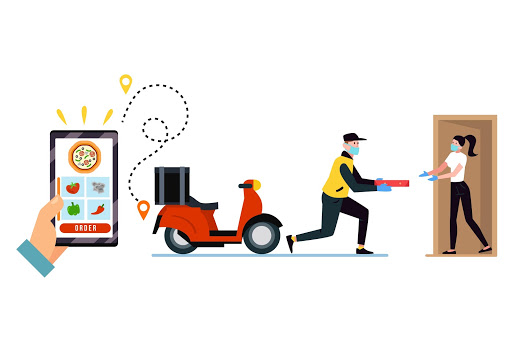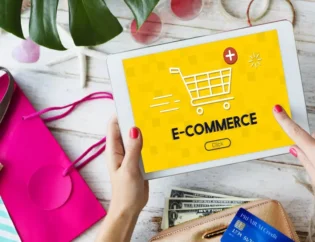
Excerpt: In this blog, we’ll go over how a hyperlocal marketplace model works, as well as its features and components. Here is a guide to a hyperlocal delivery model that will aid you in navigating the hyperlocal delivery model to the best of your ability.
Read Time: 8 mins 5 secs
Digital Commerce
Since it was discovered, the hyperlocal marketplace model, also known as on-demand near me delivery, has generated a lot of noise. The enthusiasm is understandable because the hyperlocal delivery model provides both sellers and buyers with ease and efficiency. The popularity of the Hyperlocal marketplace model is rapidly growing, owing to the fact that products are delivered to clients in a significantly shorter time frame. Many businesses are adopting this strategy since it opens up doors of opportunity for small business owners.
A Quick Guide to Hyperlocal Delivery Model

We’ll assume that if you’re still reading, you’re excited to adopt the hyperlocal delivery model into your online business. So, here’s your get-to-know list for the hyperlocal model, so you know exactly what you’re getting into.
Hyperlocal Marketplace Model and Its Concept

As the name implies, a hyperlocal marketplace caters to the demands of a small geographic area. A tour of your neighbourhood will very certainly lead you to a similar market, whether large or little, but self-sufficient in its own right, meeting practically all of the needs of the locals.
A hyperlocal system is the newest buzzword in the e-commerce world. Since the rise in popularity of hyperlocal e-commerce platforms, grocery delivery, ordering food, house care, personal care services, and other services have taken on a new dimension.
Since the birth and rise of hyperlocal platforms, local offline merchants and service providers have gotten a new lease of life. Although the notion is new, the world is no longer fresh to it, thanks to the widespread use of the internet. It has the potential to take offline retailers’ businesses to new heights.
The capacity of hyperlocal e-commerce enterprises to offer items and services at breakneck speeds is their USP. Hyperlocal delivery models guarantee that clients will receive the product they ordered in as little as an hour. Thanks to hyperlocal platforms, anything from ordering food from restaurants that don’t normally deliver to getting groceries you need in a hurry has become a lot more possible and easier.
This is the ideal time to go online, particularly for offline retailers that may be experiencing business ups and downs as a result of the crisis. It would be a great option to start an online business today so that you may develop even after the COVID19 disaster.
What is the process in which the e-commerce hyperlocal market works?

The hyperlocal marketplace concept is a great example of how technological developments may be combined with long-standing traditional buying techniques to create a winning recipe.
A hyperlocal business is a platform that allows local offline businesses to connect with their target clients and deliver products on time. A hyperlocal business’s service radius could be anything from a few metres to a few kilometres from its physical location.
Because of the hyperlocal space’s narrow geographic scope, local businesses are essentially guaranteed visibility and clients until they can demonstrate good product and service quality. It ensures that products are delivered quickly and from a reliable store close to the customer’s home.
A hyperlocal marketplace works by delivering goods and services to customers from offline establishments within a few kilometres of their location. Consider not only FMCG but also home maintenance, grooming, and other customer-valued services. So, if a neighbouring restaurant does not offer food delivery, a hyperlocal business can come in and fill the gap. Such company concepts benefit greatly from the use of a mobile application.
Today, some markets enable goods delivery within 24 hours, which is commendable, but a hyperlocal marketplace can do the same thing in less than an hour(s). The buyer is attracted not only by the timeliness but also by the fact that the products are delivered from their trusted and well-known stores.
Importance of Hyperlocal Model Delivery amidst COVID-19
Because the world was attacked by a pandemic wave at the start of the year, forcing people to stay inside their homes, brick and mortar retailers were unable to meet the need for day-to-day essentials. Customers’ only option was to turn to online stores, which raised the popularity of the on-demand delivery model significantly. The COVID-19 outbreak prompted widespread panic among consumers, prompting them to stock up on critical commodities via e-commerce platforms. This leads to the conclusion that COVID-19 resulted in a significant shift in customer behaviour because it made internet shopping their only option for meeting daily necessities, and they appeared to become familiar with it. At the moment, online retailers’ primary priority is delivering goods and services in a timely manner. The same can be said for a hyperlocal delivery strategy.
This is when the hyperlocal marketplace model emerged as the ultimate saviour and leader. When it comes to on-demand delivery, the hyperlocal delivery model looks promising. This strategy is engaging enough for your online business to engage and complete speedier deliveries, as it meets current market criteria.
Future of the Hyperlocal Marketplace

Hyperlocal marketplaces and their accompanying smartphone apps are quickly gaining popularity. According to YourStory, hyperlocal marketplace entrepreneurs have raised $170 million in funding and are continuing to do so.
Because of the intriguing concept that hyperlocals are built on and the attractiveness of their future prospects, it should not be surprising if large e-commerce platforms began to acquire or invest in them. In smaller locations where e-commerce marketplaces have yet to make an impression, hyperlocal businesses have a clear edge. As a result, hyperlocal marketplaces appear to have a bright future in the years ahead.
If you wish to adopt the Hyperlocal Delivery Model, you’ll need to catalogue all of the things in your local store in a mobile app and select dedicated resources to deliver the products in the quickest time possible.
The necessary products should be purchased locally from offline retailers and delivered to consumers in a short period of time, as the term “hyperlocal” suggests. This entails selecting a reputable retailer for each region and ensuring that the quality of the merchandise is maintained. These merchants get paid compensation for delivering the requested items.
To begin, make a partnership proposal to other similar local stores that offer distinct products and services, and agree on a commission. Your hyper-local marketplace will be ready to go once you’ve established partnerships with other local businesses. To better service clients, the Hyperlocal Business Model was developed.
This graph depicts how the hyperlocal delivery model is projected to grow at a rapid pace in the future.
How does A Hyperlocal Market Delivery work?
- The very first thought that comes to mind is to choose the services you require.
When you start thinking about what items or services you’d like to deliver, you’re thinking about the hyperlocal delivery model. You’ll begin by delivering everyday necessities, restaurant cuisine, produce, and groceries. You can use local geographic locations as a target for this.
- The next step is to target a local audience that is interested in your offerings.
The second essential thought that comes to mind is targeting. If you’re wondering who should be your local target audience, consider office professionals or college students who do not live with their families, as well as elderly folks who are unable to go to the store for everyday necessities.
- Form alliances with home delivery companies or local merchants.
After determining what you need to deliver and who your target audience is, the next step is to pitch local businesses and delivery firms for a collaboration.
You can start your firm without forming a partnership with either of them right away, or you can simply act as an aggregator of neighbouring supermarkets.
Many merchants, as I have seen, send their lads to carry groceries to the residence. As a result, you must ask these local businesses to form a relationship and request that their delivery boys transport things to your home.
- Identify and classify associations
If you obtain a lot of delivery orders, it will be profitable because delivery partners pay you per delivery and the delivery capital is left.
Which is more important: money or a contract? You can employ a delivery service or engage a group of youthful delivery guys.
In addition to gaining commission, collaborating with adjacent retailers will speed up the delivery of the on-demand delivery method. That is, a wise shipper partner will have the delivery ready, and the delivery boys will not need to buy anything before dashing to the delivery location.
- Create an income model.
You can work with nearby retailers to earn a commission for picking their products. This may lead you to restrict your activities to specific shippers in a specific area, limiting your operations in the long term.
You can also charge customers a convenience fee in addition to the delivery fee. Customers expect you to give a delivery discount if the order is too large, but the convenience fee will save you a few dollars regardless.
- Create a portable hyperlocal application
Create your hyperlocal app. For this case, make various apps for distinct characters such as drivers, shippers, and clients. I looked on the internet and came across these designs for a client application, a vendor application, and a delivery kid application.
Advantages of Establishing a Hyperlocal Marketplace
Hyperlocal Marketplace’s Key Characteristics
- Auto-detection of customer’s location
- Multiple online payment methods
- Shipment scheduling
- Product filtering based on location
- Social sharing options
- Reviews and ratings for products and services
Admin Features
- Multiple ship locations and zip codes can be added by the administrator.
- Filters can be put up in a variety of ways by the administrator:
- Filter products by distance
- Filter products by zip code
- Filter products by city, country, and state
Vendor Features
- Multiple shipping zones and zip codes are available to sellers.
- The ship location can be edited or removed by the seller.
- Auto-retrieve the vendor’s correct location.
Customer Features
- The customer’s geolocation is automatically detected.
- Filtering products throughout the site according to the observed location
- Possibility of altering a previously stated location
- Validation at the point of sale
Conclusion
Anything like cabs, cars, bikes, or public transportation can be used for hyperlocal delivery, and it can happen with anything like car service, grocery, food, and so on. The majority of hyperlocal delivery methods today are just in time. Building relationships with other merchants and delivery companies, as well as targeting the correct audience and developing a fantastic mobile app, require time. All of these factors, however, will offer your company the competitive edge it needs.
If you want to know more about this, get in touch with us here! (Hyperlink here with the Native Byte website contact page).










